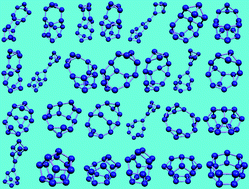Magnetic properties of individual carbon clusters, clusters inside fullerenes and graphitic nanoribbons†
Abstract
Electronic and magnetic properties of all sp2carbon species with N = 10–14 atoms (non-fullerenes clusters, rings, linear chains, zigzag and armchair ribbons) are investigated using many-body schemes. The correlated π-electrons are treated by means of the single band Hubbard model. The ground-state energy, wave function and the total spin are calculated using the Lanczos numerical diagonalization method. We found that clusters could exhibit spin switching when the electron–electron interaction is increased (a transition from singlet to triplet state) driven by Hund’s rule. Among the magnetic clusters found in this study, we usually observed carbon chain morphologies containing two interconnected clusters joined by one or two bonds. We also investigated the magnetic properties of doped clusters by adding one hole or one electron. In particular, it was found that the addition of one hole in carbon rings with N = 5, 9, 13 (generalized equation is N = 4k + 1 with k ≥ 1) results in a triplet state (S = 1), whereas one-electron doping in carbon rings shows S = 1 for N = 3, 7, 11, 15 (N = 4k − 1 with k ≥ 1). Armchair and zigzag carbon ribbons were also studied, and we found that only the zigzag ribbons exhibit a magnetic moment. In order to understand the magnetic properties and the role of cluster encapsulation in

- This article is part of the themed collection: Carbon nanostructures

 Please wait while we load your content...
Please wait while we load your content...